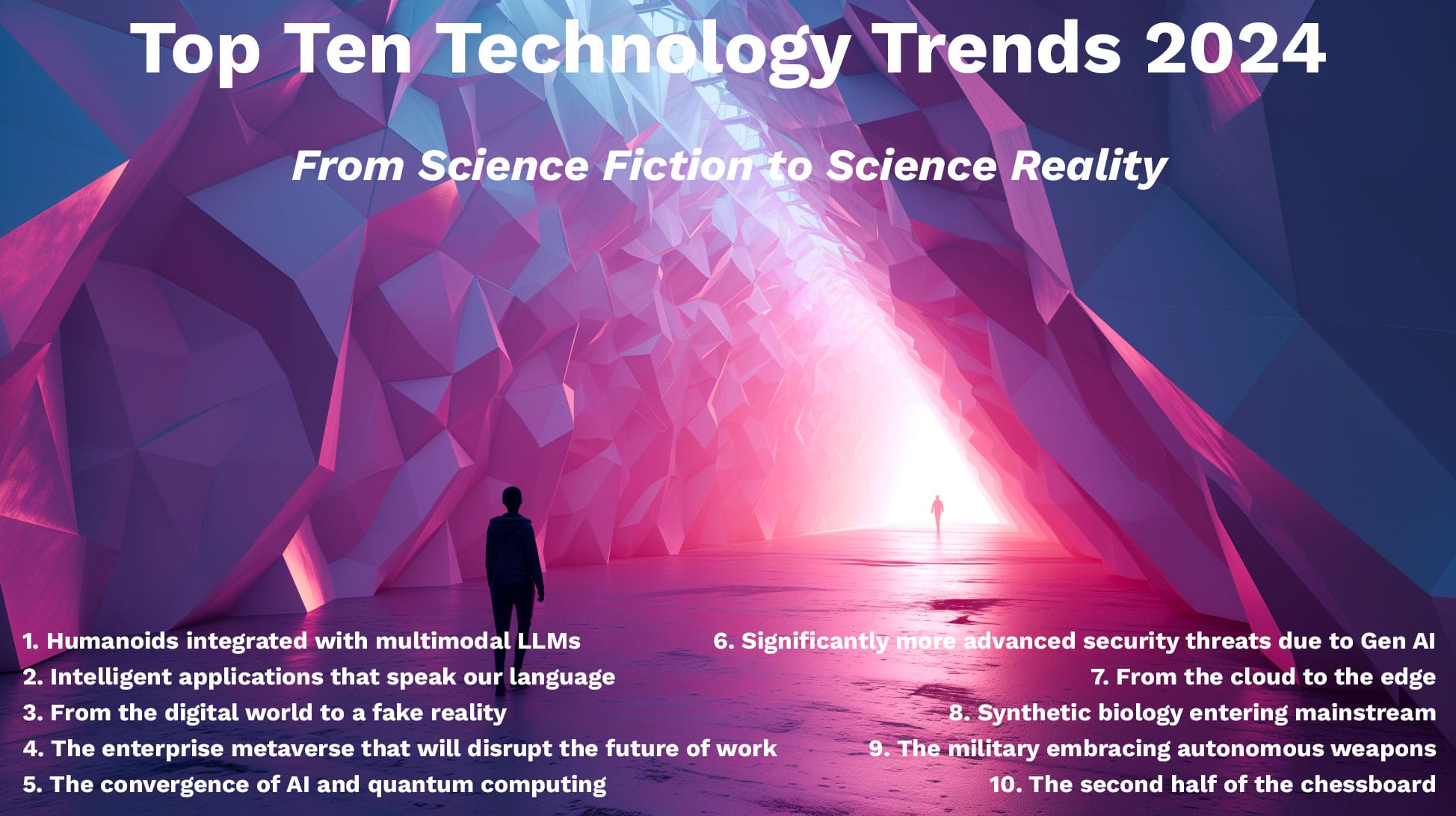Top Ten Technology Trends for 2024

As we entered 2024, the tech landscape is gearing up for another wave of innovations that will significantly impact our daily lives. Building on the past year's developments, we're on the brink of witnessing practical changes that will shape how we live, work, and connect. From upgraded virtual reality experiences to the ongoing evolution of synthetic biology and the influence of edge AI, 2023 was indeed the year of digital disruption. Before we look at what's in store for us in the year ahead, let's first analyse my technology predictions for 2023.
The year 2023 proved to validate many of my technology forecasts from last year. Virtual and augmented reality continued its momentum, accelerated by Apple's entrance into the market with the Apple Vision Pro headset. This affirmed my prediction that Apple's influence could catalyse VR adoption.
Meanwhile, blockchain and associated technologies like NFTs endured growing pains but remained integral to digital finance and ownership structures. The hype around NFT valuation may have dipped, but the underlying tech is evolving. My forecast around Web3 also actualised as developers migrated from proofs-of-concept to more robust platforms and applications, including the growth in Ethereum SDKs and wallet SDKs and the rise of layer two blockchains like Polygon and Optimism. Although Web3 continued to evolve, Big Tech exploded, as recent Accel data revealed that the market capitalisations of the largest technology companies worldwide experienced a remarkable increase of $2.4 trillion in 2023.
I correctly anticipated the advancements in AI language models, especially surrounding ChatGPT. These systems continued maturing while spreading into more industries. However, biases and limitations still challenge wide deployment. Alongside language AI, I predicted generative models would propel the metaverse forward, using AI-generated audio, video, and entire virtual worlds. The significant advancements in these fields, including companies such as Elevenlabs, RunwayML and Midjourney, have reduced costs and enhanced creative capacity that will impact the metaverse.
Regarding sustainability, most blockchain platforms besides Bitcoin boosted eco-friendly attributes, meeting my expectations. Significant efforts like Ethereum's transition to the proof-of-stake protocol and the focus on energy-efficient hardware and model architecture confirmed this trend. I also foresaw the necessity of improved digital literacy as these technologies permeate society. Educational institutions responded by incorporating relevant skills training into curriculums.
Cyber threats posed another correct forecast as attacks grew more destructive and frequent in 2023. Hackers targeted high-risk vulnerabilities across sectors. Recent speculation suggests that OpenAI's Q* may have breached encryption, underscoring the heightened importance of security measures. As rumours circulate, the potential implications for digital security emphasise the need for robust safeguards in the evolving technological landscape.
On a brighter note, I anticipated increased robotic process automation. RPA spread as companies integrated AI and lowered deployment barriers for small businesses. Finally, technologies prioritising sustainable materials and operations gained favour with corporations and consumers alike, satisfying my prediction.
In summary, 2023 bore out many of my tech forecasts from the past year. The continued evolution of VR, AI, Web3, sustainability efforts, and other domains tracked closely with my projections. Of course, new advances always surprise me, but I feel renewed confidence in spotting broad technology trajectories into the future. So, let’s dive into my ten technology predictions for 2024.
2024: From Science Fiction to Science Reality

As we make our way through the technological landscape of 2024, we stand at the precipice of a remarkable era — one that I've aptly dubbed "The Year of Science Reality." This designation encapsulates a profound and transformative shift, signifying the departure from the speculative realms of science fiction to the palpable and impactful terrain of science reality.
In this era of unprecedented innovation, concepts that once thrived solely within the imaginative narratives of novels and cinematic tales have been seamlessly woven into our everyday lives. What was once deemed futuristic fantasy has transcended the confines of imagination, emerging as practical, real-world applications that shape and redefine our existence. Overall, I expect the following ten technology trends to take shape in 2024:

- Humanoids integrated with multimodal LLMs.
- Intelligent applications that speak our language.
- From the digital world to a fake reality.
- The enterprise metaverse that will disrupt the future of work.
- The convergence of AI and quantum computing.
- Significantly more advanced security threats due to Gen AI.
- From the cloud to the edge (AI).
- Synthetic biology entering mainstream.
- The military embracing autonomous weapons.
- The second half of the chessboard.
This analysis looks at the top ten technological trends poised to define 2024. It's a journey through the landscape where the hypothetical becomes tangible, where the once-unimaginable gracefully gives way to the ascendancy of science reality. As we explore each trend, we'll witness the unfolding narrative of technology solidifying the notion that we live in a time when science fiction has fallen in step with science reality.
Below is a summarised version of the in-depth 2024 technology trends report, which you can download free of charge by completing the below form.
1. Humanoids and Multimodal LLM Integration

Among the many transformative trends shaping the year ahead, the integration of Humanoids and Multimodal Large Language Models (LLMs) stands out as a remarkable stride forward. This synergy is redefining how we interact with machines and sparking conversations about the emergence of a new species.
In 2024, the fusion of advanced robotics and multimodal Large Language Models (LLMs) is set to revolutionise the capabilities of humanoid robots. This integration marks a significant leap forward, enabling robots to operate seamlessly in real-world environments by harnessing the power of both auditory and visual perception. Multimodal LLMs, exemplified by cutting-edge technologies such as Google Gemini and ChatGPT 4 Multimodal, enhance the robots' ability to 'hear' and 'see,' facilitating a more nuanced and interactive engagement with the world. This convergence is poised to redefine human-robot interactions, paving the way for robots that execute tasks precisely and comprehend and respond to the surrounding environment more akin to human perception.
The era of multimodal LLM-integrated robotics holds immense potential for transforming how we coexist and collaborate with these intelligent machines. In warehouses, Boston Dynamics' Atlas streamlines logistics with unmatched efficiency. Softbank Robotics' Pepper brings versatile assistance into homes as a companion. Tesla's Optimus 2 points towards roles in professional and personal environments. Equally intriguing are emotional capabilities like facial recognition and expressing emotions seen in Engineered Arts' Ameca. Healthcare robots like Moxi establish genuine connections through empathy. As humanoids permeate our lives, their emotional intelligence may be key in forming bonds that enrich human relationships. The implications are far-reaching, requiring adaptability as robots redefine manual labour and caregiving roles.
As humanoids become more sophisticated and integrated into society, questions about the emergence of a new species are beginning to surface. Ethical considerations, legal frameworks, and societal implications surround the concept of humanoid rights and responsibilities. The year 2024 may well be remembered as the period when the term "new species" entered the lexicon, signifying a paradigm shift in our understanding of intelligent machines.
2. Intelligent Applications and the Internet of Things

The seamless integration of Intelligent Applications with the Internet of Things (IoT) is poised to redefine how we interact with our digital environment in 2024. This convergence enhances the functionality of smart devices and brings about a paradigm shift in communication, fostering personalised and dynamic user experiences.
Integrating smart devices with Large Language Models (LLMs) heralds a new era of connectivity and understanding, which some call the artificial intelligence of things. Devices are becoming more than mere tools; they are evolving into intelligent companions capable of comprehending and responding to human language in nuanced ways. A prime example is the integration of virtual assistants like Amazon's Alexa and Google's Assistant into various smart devices, ranging from smart speakers to home automation systems. These assistants leverage sophisticated LLMs to interpret user commands, making interactions more natural and intuitive.
The integration of large language models (LLMs) into everyday technology in 2024 will be transformative across multiple domains. Smart speakers like Amazon Echo and Google Home will gain more natural conversational abilities from LLMs, revolutionising user experiences. Apple's reported breakthrough allowing on-device LLM integration points to AI-powered iPhones. LLMs in smart home devices will enable seamless voice control for an "Internet of Things" experience. Amazon's Alexa LLM integration into Fire TV and Echo devices demonstrates the potential to elevate smart TVs. AI wearables like Humane's AI Pin or the 'rabbit' AI will pioneer more intimate human-device relationships, paving the way for mass adoption in 2025 and 2026. The automotive industry is on the cusp of change with Geely's in-vehicle LLM infotainment system, which could redefine autonomous driving through advanced voice interactions. As LLMs become embedded into the fabric of our daily lives in 2024, they promise more intuitive, personalised and intelligent interactions across the board, from homes to cars and beyond. The next generation of technology looks to make conversational AI the norm.
As we navigate the interconnected landscape of 2024, integrating LLMs into smart devices streamlines daily tasks and transforms our digital interactions into a conversational, personalised, and anticipatory experience. This symbiotic relationship between technology and the user represents a pivotal moment in the evolution of intelligent applications and the IoT, promising a future where our devices understand what we say and anticipate what we need.
3. Digital Reality to Fake Reality

The evolution of digital reality to fake reality emerges as a double-edged sword, powered by advanced game engines and giving rise to hyper-realistic deepfakes. This transformation revolutionises immersive gaming experiences and raises critical concerns about the impact on real-world scenarios, including elections.
The prowess of advanced game engines has reached unprecedented heights, blurring the lines between the digital and physical realms. Game Engines like Epic’s Unreal Engine 5 push the boundaries of realism in virtual environments, enabling game developers to create visually stunning and immersive experiences. These engines leverage cutting-edge technologies such as real-time ray tracing and high-fidelity graphics, delivering levels of detail that were once reserved for cinematic productions. This not only elevates the gaming industry but also sets the stage for creating hyper-realistic simulations that mimic the intricacies of the real world.

Moreover, the advent of hyper-realistic deepfake technology by AI pioneers like Google DeepMind, Runway, and OpenAI has resulted in a post-truth world where distinguishing between reality and fabrication becomes increasingly blurry. While their ability to generate convincing fake videos, audio and imagery is impressive, it raises profound ethical concerns, given the potential for abuse through manipulated political speeches and celebrity impersonations.
Startups like Truepic aim to counter deepfakes via digital authentication technologies. However, the threat to electoral integrity and political discourse is significant, as hyper-realistic deepfakes make staging events or altering speeches more feasible. This poses a monumental challenge to upholding democratic principles in an era where genuine information competes with manipulated content. The use of generative AI in US political campaigns, for purposes ranging from volunteer calling to image generation, has triggered controversy despite adoption across party lines. Meta's policy curbing certain applications indicates apprehension about misinformation and disinformation. As generative AI permeates politics, balancing innovation and ethics while safeguarding transparency remains crucial. Its emergence has triggered vital debates at the intersection of technology and democracy.
The power of advanced game engines and the creation of hyper-realistic deepfakes present us with awe-inspiring possibilities and formidable challenges. 2024 will be the year of deepfakes, which is extremely worrying as 2024 will be the year with the most elections ever (4 billion people across 60 countries). As startups innovate in these domains, it becomes imperative to balance technological advancement and ethical responsibility, ensuring these powerful tools serve the greater good without becoming instruments of manipulation and misinformation in our increasingly interconnected world.
4. The Enterprise Metaverse and the Augmented Workforce in 2024

2024 holds the prospect of groundbreaking advancements in the enterprise metaverse and the harmonious augmentation of the workforce. Key players in this evolution include companies like Varjo and others, spearheading the development of advanced AR/VR enterprise headsets. Notably, the much-anticipated launch of Apple's VisionPro adds another dimension to this evolution, signifying a significant stride towards integrating augmented reality into the professional realm. As these pioneering companies continue to shape the future of immersive technologies and the spatial web, 2024 promises to redefine how businesses operate, and individuals engage within the augmented landscape of the enterprise metaverse.
The enterprise metaverse is undergoing a transformation, with innovations resulting in the on-the-fly creation of immersive 3D environments that enable real-time collaboration and boost productivity. It is set to revolutionise corporate functions through virtual meetings, training and design projects, ushering in interconnected workspaces. The convergence of AI and AR will enhance experiences via intelligent insights and interactions in augmented environments. It holds vast potential for training, assistance and data visualisation for enterprises. As AR and AI synergise, they promise to redefine information sharing and use at work.
Digital twins, powered by AI, enable intelligent simulations and predictive insights, improving decision-making. With AR, they create immersive data visualisations to foster understanding. As foundations of the enterprise metaverse, they facilitate an interconnected space where users engage with intelligent content and simulations. This metaverse, complemented by AR, enables seamless collaboration. The synergy with AI facilitates remote assistance and training through real-time monitoring, predictive maintenance and immersive scenarios, optimising processes and efficiency across industries. Integrating digital twins, AI, AR and the metaverse brings a paradigm shift in how we simulate, collaborate and make data-driven decisions.
As we envision the trajectory of the enterprise metaverse and the augmented workforce in 2024, the integration of advanced AR/VR headsets signals a significant stride towards more connected and efficient workspaces envisioned by the enterprise metaverse. The coming year holds the promise of a digital landscape where augmented reality and artificial intelligence converge seamlessly, empowering enterprises to unlock new dimensions of productivity and innovation.
5. The convergence of AI and quantum computing

Quantum computing developments promise to usher in a new era of enhanced efficiency, security and previously unattainable capabilities for enterprises. The recent milestone of surpassing the 5000 qubit barrier in quantum computing marks a pivotal moment in the field, unlocking unprecedented computational power.
The strides in quantum computing, particularly in surpassing the formidable 5000 qubit milestone, are deeply rooted in ongoing research endeavours at universities, research labs, and major technology companies worldwide. The realism of this trend is substantiated by noteworthy developments in prominent institutions and industry leaders, including Google and IBM, and significant progress in quantum research in China.
Google has claimed quantum supremacy through its Sycamore processor, surpassing supercomputers for specialised tasks. IBM pushes boundaries through its Quantum Volume metric and research collaborations via the IBM Quantum Network. China has invested extensively in quantum research at institutions like USTC and CAS, achieving milestones in quantum communication and computing. Universities worldwide, like MIT Caltech and ETH Zurich, drive fundamental quantum mechanics research and algorithm development.
In tandem with these advancements, the imminent activation of a neuromorphic supercomputer named DeepSouth, set to switch on in 2024, adds another layer to the technological landscape. This supercomputer can execute 228 trillion synaptic operations per second, a scale on par with the estimated number of operations in the human brain. As quantum computing propels forward, deploying such neuromorphic supercomputers further underscores the transformative potential of cutting-edge technology, bringing us closer to simulations of unparalleled complexity and sophistication.
Looking ahead, converging quantum computing and AI will enable transformative breakthroughs. In 2024, quantum computing's processing power can significantly accelerate AI, enhancing data analysis, pattern recognition and optimisation. Meanwhile, AI can optimise quantum circuits and error correction. This synergy will disrupt sectors like drug discovery, finance, logistics and more by jointly enabling predictive modelling, simulations and optimised planning.
These breakthroughs pave the way for transformative applications, setting the stage for an era where the synergy of quantum computing and artificial intelligence will redefine how we process information and solve complex problems.
6. Evolving Security Threats due to GenAI

The digital world is poised to witness a surge in evolving security threats, presenting a formidable challenge for cybersecurity experts and organisations. Anticipating advanced forms of cyberattacks, hyper-personalised phishing emails, and targeting private large language models through code injections, the year ahead demands heightened vigilance and innovative cybersecurity solutions from both organisations and countries.
The cyber threat landscape is intensifying with advanced attacks like sophisticated ransomware, zero-day exploits and adaptable AI-driven malware expected in 2024. Startups like Darktrace are pioneering AI-powered proactive security, while quantum-safe encryption by companies like ISARA Corporation will be crucial against quantum computing risks. Recent incidents like the Clop group's MOVEit campaign, the Barracuda ESG appliance vulnerability exploited by UNC4841, and the Microsoft cloud email breach targeting US officials showcase the multifaceted and persistent nature of evolving threats.
Hyper-personalised phishing is an emerging tactic, with criminals customising emails using personal data. Startups like Tessian aim to detect this with behavioural analysis. A concerning trend is code injections targeting private LLMs, which companies can address through secure design, could enable data breaches, content manipulation and trust erosion. The landscape is uncertain with rumours swirling about OpenAI's mysterious Q* algorithm that purportedly cracks encryption. But agility in deploying proactive measures remains key against the mutable threat ecosystem, upholding security in our interconnected world.
In 2024, the cybersecurity environment is poised for significant shifts as more sophisticated attacks loom on the horizon. Particularly, there is a potential for breakthroughs in breaking encryption methods, traditionally safeguarded by the theoretical strength of quantum computing. If these expectations materialise, the consequences could be profound, ushering in a transformative era where the balance of power might shift from countries to companies. This pivotal juncture in cybersecurity suggests that organisations and countries must be vigilant and proactive in adapting to emerging threats, potentially reshaping the dynamics of influence and control in the digital age.
7. From the Cloud to the Edge (AI)

The transition from the cloud to the edge is a defining trend in 2024. The growing importance of Edge AI and the rise of decentralised computing with powerful devices signal a paradigm shift that promises to reshape how we process and leverage data.
With its ability to process data locally on devices, Edge AI is becoming pivotal in 2024. Startups like Edge Impulse enable edge devices to make intelligent real-time decisions, reducing latency, improving privacy, and optimising bandwidth versus cloud reliance. In 2024, expect Edge AI to surge across smart cities, healthcare diagnostics and more. Apple's on-device LLMs milestone also highlights privacy and efficiency commitment. Multiple factors drive Edge AI's rise: the need for instant responsiveness in applications like autonomous vehicles, where reduced latency is critical; efficient bandwidth usage by processing data locally versus transmitting to the cloud; enhanced privacy/security by avoiding external server reliance; and real-time decision capabilities for robotics. Healthcare could also benefit through patient monitoring and data privacy.
Decentralised computing with powerful edge devices will also rise in 2024, with startups like SiFive developing customisable processors. This distributed architecture, where processing is closer to data sources, provides speed, resilience and security benefits. It is well-suited for applications from real-time manufacturing analytics to immersive mobile AR. The shift signifies a new paradigm beyond cloud reliance, with powerful edge devices driving localised intelligence.
In 2024, the journey from the cloud to the edge represents a seismic shift in how we approach data processing and computing. The rise of Edge AI and decentralised computing heralds an era where the capabilities of powerful devices are harnessed to process information closer to where it is generated, unlocking new possibilities and efficiencies in diverse industries. The fusion of intelligent edge devices and decentralised computing is set to redefine the technological landscape, paving the way for a future where data is not just stored and processed but seamlessly integrated into our daily lives in real time.
8. Synthetic Biology Entering Mainstream

When it comes to cutting-edge technologies, synthetic biology is poised for rapid evolution in 2024, with groundbreaking developments that echo the transformative potential witnessed in other fields, akin to the 'ChatGPT moment.' As innovations in DNA manipulation accelerate, the coming year holds promise for unprecedented advancements, sparking ethical and scientific considerations.
Led by pioneers like Ginkgo Bioworks, synthetic biology will experience rapid evolution, redefining healthcare to agriculture. With accelerated innovation in engineering, circuitry and organisms, the convergence with AI tools adds potential, demonstrating harmony between AI and biological engineering. This synergy propels tailored genetic materials and extends AI’s influence, marking an era where data-driven insights shape scientific discovery.
2024 could mark a 'ChatGPT moment' for synthetic biology and DNA manipulation. Startups like Synthace are pioneering automation to streamline biological experiments, resembling ChatGPT’s impact. This leap could enable unprecedented precision in DNA manipulation with vast implications from accelerated drug discovery to bespoke industrial organisms.
The convergence of technological advancements and ethical considerations in synthetic biology invites us to reflect on this technology's potential to reshape our capabilities in manipulating the building blocks of life. The profound impact of synthetic biology on medicine, agriculture, and beyond emphasises the need for responsible innovation and ethical frameworks to ensure that these powerful tools are wielded for the betterment of humanity. 2024 promises not only to unlock new possibilities in synthetic biology but also to prompt thoughtful conversations about the ethical boundaries and societal implications of manipulating the very essence of life.
9. The military embracing autonomous weapons.

The context of military affairs is undergoing a profound transformation in 2024, driven by the rapid integration of AI and emerging technologies, also known as Military AI. As the world grapples with ongoing conflicts in multiple locations, including Ukraine, Gaza, Sudan, and others, the crucible of these situations serves as a potent catalyst for the weapons industry. The relentless demand for advancements drives the evolution of ever-more sophisticated and autonomous weapons, ushering in a new era of warfare with global implications that demand careful consideration.
Emerging technologies like AI, robotics and drones are reshaping warfare, enhancing situational awareness and decision-making. The ongoing Ukraine conflict marks the first drone war, underscoring autonomous weapons' increasing role. However, deploying AI-enabled Pentagon weapons has raised alarms about risks to human survival despite the military's relentless pursuit of AI capabilities. This juxtaposition highlights ethical and existential questions about advanced technologies in warfare. 2023 research by Automated Decision Research provides insights into global perspectives on human control over autonomous weapons, emphasising digital dehumanisation concerns.
Deploying advanced and autonomous weapons is a defining feature of military advancements in 2024. Startups like Shield AI are pioneering the development of autonomous systems designed for reconnaissance and surveillance, illustrating the growing reliance on unmanned technologies. The use of AI-driven drones, robotic ground vehicles, and autonomous weapon systems is becoming more prevalent, raising ethical and strategic questions about the nature of warfare. While these technologies offer the potential for reduced human casualties and enhanced precision, they also pose challenges related to accountability, control, and adherence to international laws governing armed conflict.
The lack of a comprehensive ban on autonomous weapons has led to varying military AI stances among major countries. While guidelines exist in the US, both Russia and China actively pursue autonomous capabilities while recognising the significance of AI. Ongoing international dialogues are crucial to ensure responsible use and mitigate risks. The advent of AI brings global implications, ushering in a digital war where cyber operations and information warfare shift geopolitical power dynamics.
Integrating advanced technologies into warfare raises ethical, legal, and geopolitical challenges. The responsible development and deployment of these technologies demand a thoughtful and transparent approach to mitigate risks and ensure that the benefits contribute to global stability rather than exacerbate tensions. Despite these challenges, we can expect significant 'advancements' in developing autonomous weapons in 2024. The coming year holds the promise of continued innovation in military affairs, prompting a critical reflection on the ethical and strategic implications of the evolving nature of warfare in the digital age.
10. The Second Half of the Chessboard

With ever-accelerating technological advancements, 2024 marks the ascent into "The Second Half of the Chessboard." The metaphor, inspired by the doubling nature of technological progress, symbolises a period where the pace of innovation reaches unprecedented heights. As we prepare to traverse this dynamic environment, staying up-to-date becomes paramount, and integrating new technologies is critical for maintaining competitiveness.
The second half of the chessboard signifies a phase where technological advancements continue and accelerate exponentially. Startups such as Neuralink, founded by Elon Musk, exemplify this trend by delving into brain-machine interfaces. In 2024, we can anticipate breakthroughs in fields like quantum computing, biotechnology, brain-computer interfaces, and artificial intelligence that push the boundaries of what was once deemed possible. The exponential growth in computing power, data analytics, and connectivity is set to reshape industries, fueling innovations that range from personalised medicine to sustainable energy solutions.
As technological advancements accelerate, integrating new technologies becomes a decisive factor in maintaining competitiveness. Startups like Snyk, focusing on cybersecurity for modern applications, exemplify the role of technology integration in addressing contemporary challenges. In 2024, businesses that strategically adopt and integrate cutting-edge technologies, such as artificial intelligence, blockchain, and 5G, will gain a competitive edge. From enhancing operational efficiency to delivering innovative products and services, the seamless integration of new technologies is the cornerstone of staying ahead in a rapidly evolving market.
In the second half of the chessboard in 2024, the acceleration of technological developments presents both challenges and opportunities. Staying up-to-date and embracing a continuous learning mindset will be essential for individuals and organisations seeking to thrive in this dynamic environment. The necessity of integrating new technologies not only ensures competitiveness but also positions innovators to shape the future landscape, contributing to the ongoing narrative of human progress in the digital age.
Conclusion: From Science Fiction to Science Reality

As we conclude our exploration of the state of technology in 2024, several key trends emerge, painting a vivid picture of a world in rapid transformation as we move from science fiction to science reality. From the integration of Humanoids and Multimodal Large Language Models (LLMs) to the evolution of the enterprise metaverse and the rise of decentralised computing, the second half of the chessboard is undeniably a stage for groundbreaking innovation. 2024 will, therefore, be the year that science fiction turns science into reality.
In the realm of Humanoids and LLMs, we witness the blurring of boundaries between man and machine, raising questions about the emergence of a new species. Emotional capabilities in robots are shaping their functionality and the nature of human-robot interactions, ushering in a new era of companionship and collaboration. The Jetsons era has truly started.
The enterprise metaverse and the augmentation of the workforce through Edge AI signal a shift in how we collaborate and process information. The convergence of quantum computing and AI promises to unlock computational capabilities beyond our current understanding, presenting opportunities for groundbreaking discoveries and advancements.
On the flip side, we must navigate the challenges posed by evolving security threats and the potential pitfalls of synthetic biology. As we embrace the power of AI in military applications, ethical considerations and responsible innovation become critical to ensuring a future where these technologies serve humanity rather than endanger it.
In this dynamic panorama, the call to action for businesses is clear: adapt or be left behind. Staying up-to-date with emerging technologies is no longer a luxury but a strategic necessity. The second half of the chessboard demands a mindset of continuous learning, where businesses proactively integrate new technologies, hopefully responsibly, to maintain competitiveness.
That is why I recommend downloading my new The Digital Speaker mobile app, which is a unique experience beyond the traditional newsletter - giving users direct access to real-time insights, recommendations and conversations with my digital twin via text, audio or video in 28 languages. Visit app.thedigitalspeaker.com to receive my updates directly on your smartphone.

As we stand on the precipice of a new era, the choices we make today will shape the trajectory of tomorrow. The call to action resonates not just as a response to the technology trends of 2024 but as a testament to the enduring spirit of innovation that defines the human journey. The evolving technological landscape is a canvas upon which businesses can paint their futures – a canvas that rewards those who embrace change, adapt with agility, and pioneer the transformative solutions that define our collective tomorrow.
I wish you all the very best for 2024 and that it may become a year where evolution moves up a level, further integrating humans and machines, but hopefully in an ethical, responsible, and safe manner.
Images: Midjourney





